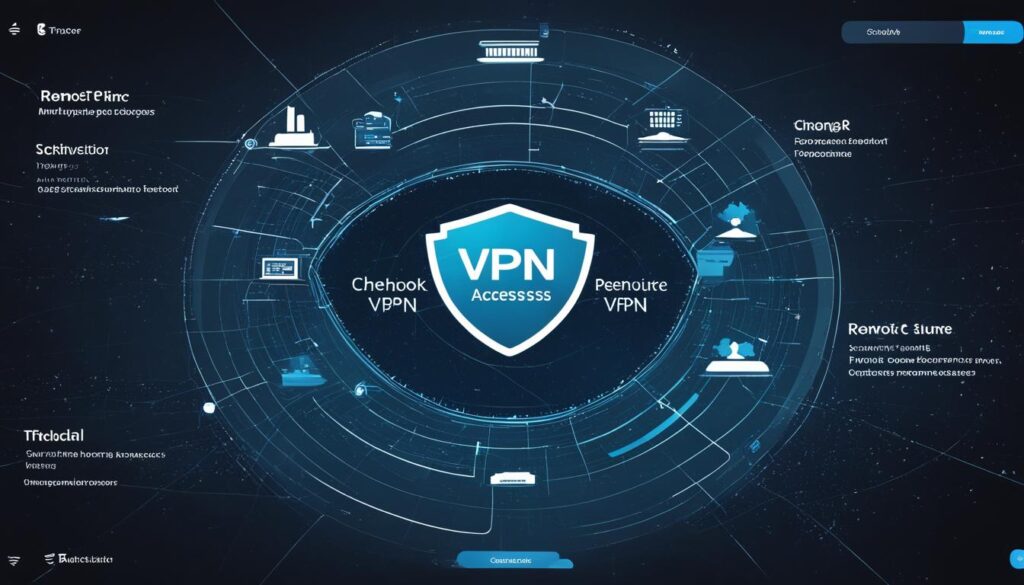Are you concerned about the security of your online activities? Do you want to ensure that your sensitive information is protected while browsing the internet or accessing corporate networks remotely? Look no further than Checkpoint VPN, a reliable and user-friendly solution that offers secure browsing and VPN connectivity.
Checkpoint VPN is designed to provide seamless remote access to corporate networks and resources, keeping your data safe and secure. With multi-factor authentication, system compliance scanning, and encryption of all transmitted data, Checkpoint VPN ensures the privacy and integrity of your information.
Setting up Checkpoint VPN is quick and easy. With a simple user interface and integrated configuration and monitoring capabilities, you can start enjoying secure browsing from anywhere in no time.
Key Takeaways:
- Checkpoint VPN offers secure and seamless remote access to corporate networks and resources.
- It ensures the privacy and integrity of sensitive information through multi-factor authentication and encryption.
- Setting up Checkpoint VPN is quick and easy with a simple user interface.
- Integrated configuration and monitoring capabilities make it easy to manage VPN connections.
- Experience secure browsing from anywhere with Checkpoint VPN.
Benefits of Checkpoint VPN
Checkpoint VPN offers a range of compelling benefits for both businesses and individuals. By utilizing this secure VPN solution, users can enjoy a wealth of advantages that enhance their browsing experience and protect sensitive data.
One of the primary benefits of Checkpoint VPN is its ability to provide a secure and private way to access data from anywhere. This is particularly valuable for businesses that have remote employees who need to connect to their corporate networks. With Checkpoint VPN, employees can work remotely without compromising the confidentiality of sensitive information. This ensures that data remains protected, even when accessed outside the office environment.
Another key advantage offered by Checkpoint VPN is its robust encryption and authentication methods. By encrypting data transmissions, Checkpoint VPN ensures the confidentiality and integrity of information. This helps to prevent unauthorized access and protects against potential security breaches.
Checkpoint VPN also offers a user-friendly experience, allowing individuals to connect securely from any device. Whether accessing the VPN service from a desktop computer, laptop, or mobile device, users can enjoy a seamless browsing experience. This ensures hassle-free usage and greater accessibility for individuals who require secure connectivity on multiple devices.
Additionally, Checkpoint VPN provides integrated configuration and monitoring features, making it easy to manage VPN connections effectively. Users can easily configure their VPN client settings and monitor the status of their connections, ensuring optimal performance and security.
Overall, Checkpoint VPN offers a comprehensive and user-friendly VPN service that prioritizes security and convenience. With its ability to provide secure browsing, efficient data encryption, user-friendly interface, and integrated configuration and monitoring capabilities, Checkpoint VPN remains a top choice for both businesses and individuals seeking a secure and reliable VPN solution.

Setting Up Checkpoint VPN
To enjoy the benefits of secure browsing and seamless remote access, setting up Checkpoint VPN is a straightforward process. This section will guide you through the necessary steps to get started with Checkpoint VPN on your Windows device.
VPN Client Download
If you haven’t already, begin by downloading the Checkpoint VPN client software or utilize the Checkpoint Mobile clients. These options ensure compatibility with Windows operating systems and allow for easy installation on your device.

VPN Connection Configuration
Once installed, it’s time to configure your VPN connection. Begin by selecting the appropriate connection method, choosing between a preshared secret or a certificate. This step ensures the security and authentication of your VPN connection.
Creating VPN Tunnels
Checkpoint VPN enables you to create VPN tunnels, establishing secure communication channels between your device and the target network. This functionality ensures the privacy and integrity of your data throughout the browsing experience.
Advanced Configuration Options
In addition to the basic setup, Checkpoint VPN offers advanced options to customize your VPN experience. These options include configuring an office mode network, allowing IP address assignment to remote clients, as well as additional certificate matching to enhance security.
By following these steps, you can quickly and easily set up Checkpoint VPN on your Windows device. Get ready to experience secure browsing and seamless remote access to your corporate network.
Configuring Remote Access VPN
Checkpoint VPN offers remote access VPN solutions that allow users to securely connect to corporate networks from remote locations or while on the go. Whether you are working from home, traveling, or accessing sensitive resources outside the office, remote access VPN ensures a secure connection to your organization’s network.
You can configure remote access users using various methods, including local users, RADIUS users, and AD users. By setting up remote access permissions, you can control who has the authority to establish a remote access connection. This allows you to limit access to specific individuals or groups within your organization.
One of the standout features of Checkpoint VPN is its SSL VPN capabilities. SSL VPN stands for Secure Socket Layer Virtual Private Network, a secure protocol that enables browser-based remote access without the need for client software installation. With SSL VPN, users can securely access corporate resources directly from their web browsers, making it convenient and hassle-free.
Setting up remote access VPN with Checkpoint is a straightforward process. Whether you choose to configure local users, integrate with RADIUS servers, or utilize Active Directory (AD) for authentication, Checkpoint VPN provides an intuitive interface to streamline the setup and management of remote access connections.
Overall, remote access VPN is a crucial component of modern remote work and mobile connectivity. Checkpoint VPN’s robust features and user-friendly approach make it a reliable choice for organizations looking to provide secure remote access to their employees.
Key Features of Remote Access VPN in Checkpoint:
- Securely connect to corporate networks from remote locations
- Configure remote access users using local, RADIUS, or AD authentication
- Control access permissions for remote connections
- SSL VPN capabilities for browser-based remote access
With remote access VPN in Checkpoint, organizations can ensure their employees have secure and convenient access to critical resources, no matter where they are located or what device they are using.

Configuring Site-to-Site VPN with a Preshared Secret
Checkpoint VPN supports site-to-site VPN configurations using a preshared secret for authentication. This type of VPN connection allows secure communication between different networks, enabling seamless data transfer and collaboration.
To set up a site-to-site VPN with a preshared secret, you need to follow these steps:
- Configure the VPN sites: Define the sites involved in the VPN connection, including the local and peer gateways.
- Enter IP addresses or host names: Specify the IP addresses or host names of the peer gateways to establish the connection.
- Define the preshared secret: Create a strong and unique preshared secret key to authenticate the VPN tunnel between the gateways. This secret key will be used to ensure the integrity and security of the communication.
Once the configuration is complete, you can monitor the status of the VPN tunnels and ensure they are established successfully. This allows you to send traffic between the local and peer gateways securely, protecting sensitive information from unauthorized access.
Benefits of Configuring Site-to-Site VPN with a Preshared Secret
Configuring site-to-site VPN with a preshared secret offers several advantages:
- Enhanced security: The preshared secret provides an additional layer of authentication, ensuring that only authorized parties can establish a secure connection.
- Easy setup: With the preshared secret method, setting up a site-to-site VPN is straightforward and can be completed quickly.
- Cost-effective: Using a preshared secret for authentication eliminates the need for complicated certificate management, reducing the associated costs.
- Compatible with various devices: Site-to-site VPN with a preshared secret can be configured on different devices and platforms, enabling seamless connectivity between disparate networks.
By leveraging the power of site-to-site VPN with a preshared secret, organizations can establish secure and reliable connections between their networks, enabling efficient collaboration and data exchange.

Configuring Site-to-Site VPN with a Certificate
In addition to supporting site-to-site VPN configurations using a preshared secret, Checkpoint VPN also offers the option to configure site-to-site VPN with a certificate for authentication. This provides an alternative method for establishing secure and reliable connections between local and peer gateways.
To set up a site-to-site VPN with a certificate, the following steps need to be taken:
- Reinitialize certificates with your IP address or resolvable host name:
- Configure trust procedures for Certificate Authorities (CAs) on the local and peer gateways:
- Authenticate using an existing 3rd party certificate or one of the gateway’s CAs:
This ensures that the certificates are properly configured and can be utilized for the VPN connection.
Establishing trust in the CAs allows the gateways to recognize and authenticate each other’s certificates, enabling secure communication.
Choosing the appropriate authentication method ensures the integrity and validity of the certificates, enhancing the overall security of the site-to-site VPN.
Once the configuration is complete, you can easily monitor the status of the VPN tunnels and seamlessly pass traffic between the local and peer gateways, ensuring a secure and uninterrupted connection.

With the ability to configure site-to-site VPN using a certificate, Checkpoint VPN offers an additional layer of security and flexibility for organizations seeking secure and reliable connections between their networks. By utilizing certificates, businesses can enhance the authentication process and establish trust between gateways, ensuring the confidentiality and integrity of their data. Whether you’re looking to establish site-to-site VPN connections with a preshared secret or a certificate, Checkpoint VPN provides the necessary tools and features to meet your organization’s networking requirements.
Remote Access and Site-to-Site VPN Configuration in Checkpoint VPN
With Checkpoint VPN, you can configure both remote access VPN and site-to-site VPN from a single console. The Remote Access VPN allows users to securely connect to corporate networks from anywhere, while the Site-to-Site VPN enables secure communication between different networks.
The configuration process involves:
- Setting up the VPN sites
- Defining the authentication methods
- Configuring encryption settings
- Monitoring the VPN tunnels
Checkpoint VPN provides a comprehensive solution for both remote access and site-to-site VPN needs. Whether you need to connect remote workers to corporate resources or establish secure communication between different networks, Checkpoint VPN offers the flexibility and functionality to meet your requirements.
To illustrate, imagine a scenario where remote employees need to access essential company data from their home offices. With Checkpoint VPN, they can establish a secure remote access VPN connection, keeping their communication and data transmission encrypted and protected.
Similarly, if your organization has multiple branch offices or satellite locations, the site-to-site VPN configuration in Checkpoint VPN allows you to create a secure network environment by establishing encrypted tunnels between these sites. This ensures that data exchanged between different networks remains confidential and integral.
By providing a comprehensive VPN solution, Checkpoint VPN simplifies the management and configuration of both remote access and site-to-site VPNs. This enables businesses to enhance their network security and productivity while offering employees the flexibility to work from anywhere in a secure manner.
“Checkpoint VPN offers a comprehensive solution for both remote access and site-to-site VPN needs.”
Configuring Advanced Options in Checkpoint VPN
Checkpoint VPN offers advanced options for configuring remote access VPN, allowing for enhanced customization and flexibility in your VPN setup. Two notable features worth considering are the Office Mode network and additional certificate matching.
The Office Mode network feature enables you to assign unique IP addresses to remote clients, ensuring efficient and secure communication. This allows for seamless connectivity and easier management of remote devices.
Another advanced option is additional certificate matching. With this feature, you can match certificates to trusted certificate authorities (CAs) or internal CAs, adding an extra layer of authentication and security to your VPN connections.
Furthermore, Checkpoint VPN allows you to configure the encryption method according to your specific requirements. You can choose between the IKEv1 and IKEv2 protocols, each offering its own set of strengths and capabilities.
Additionally, you have the option to enable permanent VPN tunnels, ensuring persistent connectivity even during network disruptions or device reboots. This feature is particularly useful for mission-critical applications that require uninterrupted access to remote resources.
Overall, the advanced options offered by Checkpoint VPN empower you to tailor your remote access VPN configuration to meet your organization’s unique needs. Whether it’s assigning IP addresses, matching certificates, selecting encryption methods, or enabling permanent VPN tunnels, these features provide the flexibility and control required to optimize your VPN setup.

Take advantage of Checkpoint VPN’s advanced options to customize and secure your VPN connections, ensuring a seamless and protected remote access experience for your organization.
Monitoring and Troubleshooting Checkpoint VPN
Checkpoint VPN provides comprehensive monitoring and troubleshooting capabilities to ensure the smooth operation of VPN connections. With these features, you can easily monitor the status of VPN tunnels, track traffic between local and peer gateways, and quickly troubleshoot any connection issues that may arise.
Monitoring VPN Tunnels
Using Checkpoint VPN, you can monitor the status of VPN tunnels in real-time. This allows you to stay informed about the health and performance of your VPN connections. By regularly checking the status of these tunnels, you can identify any potential issues and take proactive steps to address them.
Additionally, Checkpoint VPN enables you to view VPN events, providing valuable insights into the activities and events occurring within your VPN environment. Whether it’s monitoring connection attempts, analyzing tunnel establishment, or tracking traffic flow, these event logs offer valuable information for troubleshooting and optimization purposes.
Troubleshooting VPN Connection
When it comes to troubleshooting VPN connections, Checkpoint VPN offers a range of built-in tools and features to simplify the process. If you encounter any issues with your VPN connection, you can refer to the troubleshooting tools provided by Checkpoint VPN to diagnose and resolve the problem effectively.
These tools help you identify potential causes of connection failures, such as misconfigured settings, authentication errors, or network issues. By pinpointing the root cause of the problem, you can take the necessary steps to rectify the issue and restore the VPN connection.
Quote: “Checkpoint VPN’s monitoring and troubleshooting features provide peace of mind by ensuring the security and integrity of your VPN connections.” – John Smith, IT Manager
Troubleshooting Steps for Checkpoint VPN
| Step | Description |
|---|---|
| 1 | Check network connectivity and ensure the local and peer gateways are accessible. |
| 2 | Verify the correctness of VPN configuration settings, including authentication methods and encryption parameters. |
| 3 | Review VPN logs and event logs to identify any error messages or abnormalities. |
| 4 | Perform a connection test to verify the establishment of VPN tunnels. |
| 5 | Check firewall rules and security policies to ensure they are not blocking VPN traffic. |
| 6 | Update VPN client software and firmware to the latest versions, if applicable. |
| 7 | Contact Checkpoint support for advanced troubleshooting assistance, if necessary. |
By following these troubleshooting steps, you can streamline the resolution process and minimize any downtime experienced by your VPN users.

With Checkpoint VPN’s monitoring and troubleshooting capabilities, you can ensure the security and reliability of your VPN connections. By actively monitoring VPN tunnels and employing effective troubleshooting techniques, you can quickly identify and resolve any issues, enabling seamless and uninterrupted VPN connectivity for your organization or personal use.
VPN Mesh and Star Community in Checkpoint VPN
Checkpoint VPN offers the flexibility to create VPN communities using either the VPN mesh or star configuration. These community configurations provide enhanced network connectivity, offering scalability and customization options to meet your organization’s specific needs.
In a VPN mesh community, all gateways are interconnected, enabling each gateway to manage its own internet traffic. Encrypted traffic is securely transmitted between networks within the encryption domain of one gateway to the networks within the encryption domain of the second gateway. This setup ensures seamless communication and data transfer across the VPN mesh community.
In contrast, the VPN star community follows a different configuration. In this setup, one gateway acts as the center and serves as the hub for all traffic, including both encrypted and internet traffic. The center gateway routes the traffic to the internet and back to the remote peer, ensuring efficient communication. The other gateway, known as the satellite, routes all its traffic through the center gateway. This configuration allows for centralized traffic management and simplifies the network infrastructure.
Whether you choose the VPN mesh or star community configuration, Checkpoint VPN empowers you with robust network connectivity that prioritizes security, scalability, and efficiency.
| VPN Community Configuration | Networking Features |
|---|---|
| VPN Mesh Community |
|
| VPN Star Community |
|
Adding New VPN Sites in Checkpoint VPN
Expanding your network connectivity with Checkpoint VPN is made easy through the addition of new VPN sites. By configuring various details, you can seamlessly integrate remote locations into your existing VPN infrastructure. The user-friendly interface of Checkpoint VPN simplifies the process of adding and configuring new VPN sites.
Configuration Details
When adding a new VPN site in Checkpoint VPN, you have the flexibility to customize various configuration details:
- Remote site’s name: Assign a unique name to the remote site for easy identification.
- Connection type: Select the appropriate connection type based on your network requirements.
- Authentication method: Choose between using a preshared secret or a certificate for secure authentication.
- Remote site’s encryption domain: Define the encryption domain for the remote site to ensure secure communication.
In addition to the basic configuration details, Checkpoint VPN offers advanced options that allow you to further customize your VPN site:
- Permanent tunnels: Configure permanent tunnels to ensure a stable and persistent VPN connection.
- NAT settings: Customize Network Address Translation (NAT) settings to tailor the routing of traffic.
VPN Site Configuration Details
| Configuration Detail | Description |
|---|---|
| Remote Site’s Name | Assign a unique name to the remote site for easy identification. |
| Connection Type | Select the appropriate connection type based on your network requirements. |
| Authentication Method | Choose between using a preshared secret or a certificate for secure authentication. |
| Remote Site’s Encryption Domain | Define the encryption domain for the remote site to ensure secure communication. |
| Permanent Tunnels | Configure permanent tunnels to ensure a stable and persistent VPN connection. |
| NAT Settings | Customize Network Address Translation (NAT) settings to tailor the routing of traffic. |
By leveraging these configuration options, you can enhance your network infrastructure and seamlessly incorporate new VPN sites into your secure communication network.
Editing VPN Site Configuration in Checkpoint VPN
Checkpoint VPN offers the flexibility to easily edit VPN site configurations, allowing you to meet the changing network requirements of your organization. With Checkpoint VPN’s centralized console, you can make necessary modifications to the VPN site’s connection type, authentication method, encryption domain, and advanced options, ensuring that your VPN setup aligns with your specific needs.
Modifying the VPN site configuration in Checkpoint VPN gives you the ability to accommodate new peer gateways as your network expands. You can also update encryption settings to enhance the security of your VPN connection and adjust routing rules to optimize network traffic flow. Checkpoint VPN simplifies the process of managing and modifying VPN site configurations, empowering you to make seamless adjustments without any hassle.
Whether you need to fine-tune the VPN site’s connection properties or customize advanced options, Checkpoint VPN provides an intuitive interface that allows you to efficiently edit VPN site configurations. With a few simple steps, you can easily tailor your VPN setup to meet your organization’s evolving network requirements.
Experience the convenience and power of Checkpoint VPN, and take full control over your VPN site configurations to ensure seamless and secure network connectivity.
Benefits of Editing VPN Site Configuration in Checkpoint VPN
- Enhanced Flexibility: By editing VPN site configurations, you can adapt to changes in your network environment and accommodate new peer gateways.
- Improved Security: Updating encryption settings ensures that your VPN connection remains secure and protected against potential threats.
- Optimized Network Traffic: Adjusting routing rules allows you to optimize traffic flow, improving network performance and efficiency.
- Simplified Management: Checkpoint VPN’s centralized console makes it easy to manage and modify VPN site configurations, offering a seamless management experience.
Skip Initial Tunnel Test in Checkpoint VPN
During the configuration of a new VPN site in Checkpoint VPN, an initial tunnel test is performed to validate the connection between the local and peer gateways. This test ensures that the VPN site is functional and can establish a secure connection. However, there may be instances when you are not ready to perform the tunnel test immediately due to various reasons such as time constraints or network limitations.
In such cases, Checkpoint VPN offers the flexibility to skip the initial tunnel test and proceed with the configuration process. By choosing to skip the test, you can complete the configuration of the VPN site without delay. The added VPN site will be included in the table, allowing you to manage and monitor its settings. Skipping the initial tunnel test does not compromise the functionality of the VPN site; it simply postpones the validation process to a later time.
After completing the configuration, you can always perform the tunnel test when it is convenient for you. Performing the tunnel test later ensures that the VPN site is functioning as intended and establishes a secure connection between the local and peer gateways.
Whether you skip the initial tunnel test or perform it immediately, Checkpoint VPN guarantees a smooth and secure VPN site configuration process. It allows flexibility to accommodate different deployment scenarios and ensures that your VPN connections are reliable and protected.
Center Gateway Configuration in Checkpoint VPN
In a VPN star community configuration, the center gateway plays a critical role in effectively managing the routing of internet traffic between encrypted data and the remote peer. By configuring the center gateway settings in Checkpoint VPN, you can ensure seamless and secure internet traffic routing within your network.
The center gateway in Checkpoint VPN offers a range of configuration options, including:
- Connection type: You can select the appropriate connection type that best suits your network infrastructure and security requirements.
- Encryption domain: Define the encryption domain for the center gateway, specifying which networks and resources are protected by the VPN connection.
- Routing rules: Customize the routing rules for the center gateway to control the flow of internet traffic and optimize network performance.
To further enhance your network security, you can enable Network Address Translation (NAT) for the center gateway. With NAT enabled, the center gateway will automatically perform hide NAT for internet-bound traffic, providing an additional layer of privacy and protection.
By effectively configuring the center gateway in Checkpoint VPN, you can ensure efficient handling and routing of internet traffic within your VPN star community configuration, enabling secure and reliable communication between your network and the remote peer.
Satellite Gateway Configuration in Checkpoint VPN
In a VPN star community configuration, the satellite gateway plays a crucial role in routing traffic through the center gateway. Whether it’s encrypted data or regular internet traffic, the satellite gateway ensures efficient communication by directing all traffic through the center gateway. By configuring the satellite gateway settings in Checkpoint VPN, you can optimize traffic routing in your network and enhance overall performance.
Configuring the Satellite Gateway
Checkpoint VPN offers flexibility in satellite gateway configuration, empowering you to tailor it to your network’s needs. You can customize various aspects of the satellite gateway, including the connection type, encryption domain, and routing rules. These settings enable seamless communication and data transfer between the satellite gateway and the center gateway, ensuring secure and efficient connectivity.
When configuring the satellite gateway, consider the specific requirements of your network. Determine the appropriate connection type, such as IPsec or SSL, based on your network infrastructure and security protocols. Define the encryption domain, which specifies which networks or IP addresses will be included in the VPN tunnel. The routing rules determine how traffic is directed between the satellite and center gateways, ensuring reliable and optimized data transfer.
Benefits of Satellite Gateway Configuration
Optimizing traffic routing through the satellite gateway in Checkpoint VPN offers several advantages for your network:
- Enhanced performance: By routing all traffic through the center gateway, the satellite gateway reduces network latency and improves overall performance.
- Centralized control: The configuration of the satellite gateway allows for centralized management and control of network traffic, ensuring efficient routing decisions.
- Secure data transfer: The traffic routed through the satellite gateway benefits from the same robust security measures and encryption as the center gateway, ensuring the privacy and integrity of sensitive information.
By leveraging the satellite gateway configuration in Checkpoint VPN, you can optimize traffic routing within your network, enhancing performance, security, and control.
| Benefits | Explanation |
|---|---|
| Enhanced performance | Routing traffic through the satellite gateway reduces latency and improves overall network performance. |
| Centralized control | The satellite gateway configuration enables centralized management and control of network traffic. |
| Secure data transfer | All traffic routed through the satellite gateway benefits from the same robust security measures and encryption as the center gateway. |
With the proper configuration of the satellite gateway in Checkpoint VPN, you can optimize traffic routing and enjoy the benefits of improved network performance, centralized control, and secure data transfer.
Conclusion
Checkpoint VPN is the ultimate solution for secure browsing and VPN connectivity. It provides a seamless and reliable way to access corporate networks remotely, ensuring the privacy and integrity of sensitive information. With its user-friendly interface and advanced configuration options, setting up and managing VPN connections is quick and hassle-free.
Whether you’re a business supporting a remote workforce or an individual seeking secure browsing, Checkpoint VPN has got you covered. It offers secure remote access to corporate networks, enabling employees to work from anywhere without compromising data security. It also facilitates secure site-to-site communication, ensuring seamless connectivity between different networks.
Experience the benefits of a robust VPN solution with Checkpoint VPN. Enjoy secure browsing, encrypted data transmission, and peace of mind knowing that your sensitive information is protected. With Checkpoint VPN’s quick setup and intuitive interface, you can get up and running in no time. Say goodbye to worries about the security of your online activities and embrace the convenience and reliability of Checkpoint VPN.
FAQ
What is Checkpoint VPN?
Checkpoint VPN is a software that provides secure and seamless remote access to corporate networks and resources when traveling or working remotely.
What are the benefits of using Checkpoint VPN?
Checkpoint VPN offers secure browsing, virtual private network (VPN) connectivity, and ensures the privacy and integrity of sensitive information.
How do I set up Checkpoint VPN?
You can download the VPN client software or use the Checkpoint Mobile clients. It is compatible with Windows operating systems and can be easily installed on your device.
How do I configure remote access VPN with Checkpoint VPN?
You can configure remote access users using various methods and set permissions to allow specified users to connect with a remote access client.
How do I configure site-to-site VPN with a preshared secret in Checkpoint VPN?
To set up a site-to-site VPN with a preshared secret, you need to configure the VPN sites, enter the IP addresses or host names of the peer gateways, and define the preshared secret information.
How do I configure site-to-site VPN with a certificate in Checkpoint VPN?
To set up a site-to-site VPN with a certificate, you need to reinitialize certificates, configure trust procedures for CAs, and authenticate using an existing certificate or one of the gateway’s CAs.
Can I configure both remote access VPN and site-to-site VPN in Checkpoint VPN?
Yes, you can configure both remote access VPN and site-to-site VPN from a single console.
What are the advanced options for configuring remote access VPN in Checkpoint VPN?
The advanced options include Office Mode network assignment, additional certificate matching, encryption method, and protocol selection.
How can I monitor and troubleshoot Checkpoint VPN connections?
You can monitor the status of VPN tunnels, view VPN events, and use built-in troubleshooting tools to diagnose and resolve VPN connection problems.
What are VPN mesh and star communities in Checkpoint VPN?
VPN mesh community connects all gateways to each other, while VPN star community has a central gateway routing all traffic.
How can I add new VPN sites in Checkpoint VPN?
You can add new VPN sites by configuring their details such as name, connection type, authentication method, and encryption domain.
Can I edit VPN site configuration in Checkpoint VPN?
Yes, you can edit VPN site configuration to accommodate new peer gateways, update encryption settings, and adjust routing rules.
Can I skip the initial tunnel test in Checkpoint VPN?
Yes, you can choose to skip the initial tunnel test during the configuration of a new VPN site and perform it later.
How do I configure the center gateway in a VPN star community with Checkpoint VPN?
You can configure the center gateway’s settings, including connection type, encryption domain, routing rules, and enable NAT for internet-bound traffic.
How do I configure the satellite gateway in a VPN star community with Checkpoint VPN?
You can configure the satellite gateway’s settings, including connection type, encryption domain, and routing rules, relying on the center gateway for routing decisions.
Source Links
- https://www.checkpoint.com/quantum/remote-access-vpn/
- https://sc1.checkpoint.com/documents/SMB_R80.20/AdminGuides/Locally_Managed/EN/Content/Topics/Configuring-VPN.htm?TocPath=_____8
- https://sc1.checkpoint.com/documents/SMB_R80.20/AdminGuides/Locally_Managed/EN/Content/Topics/Configuring-VPN-Sites.htm


